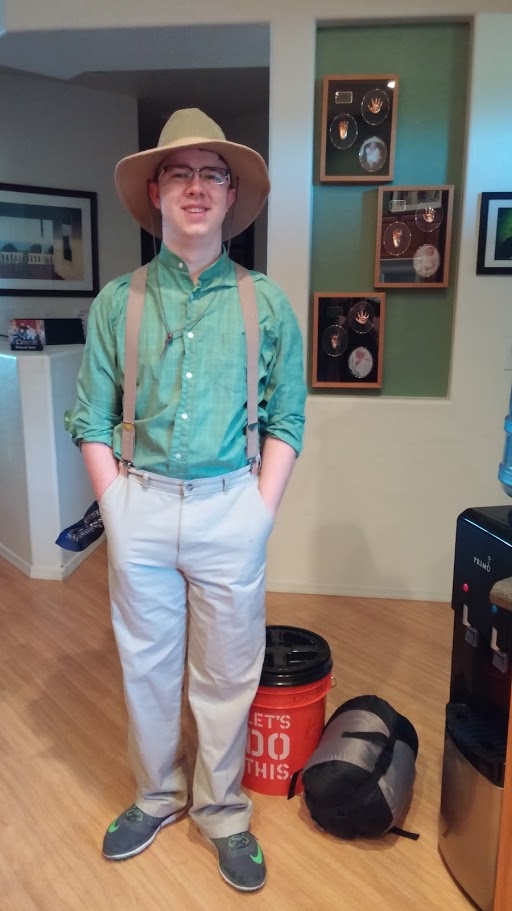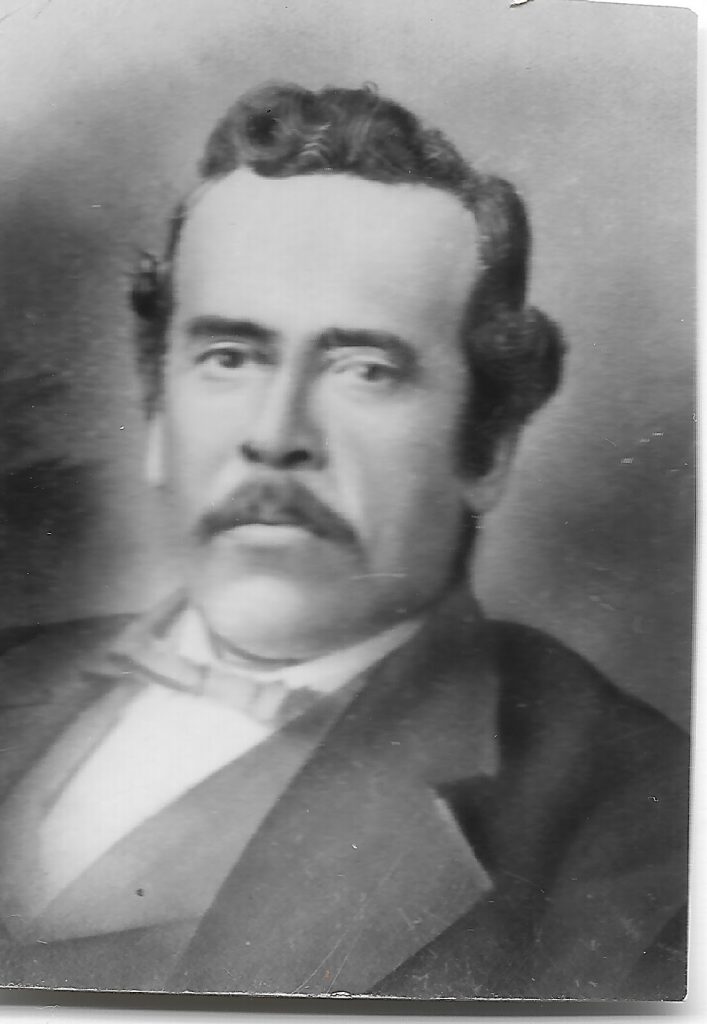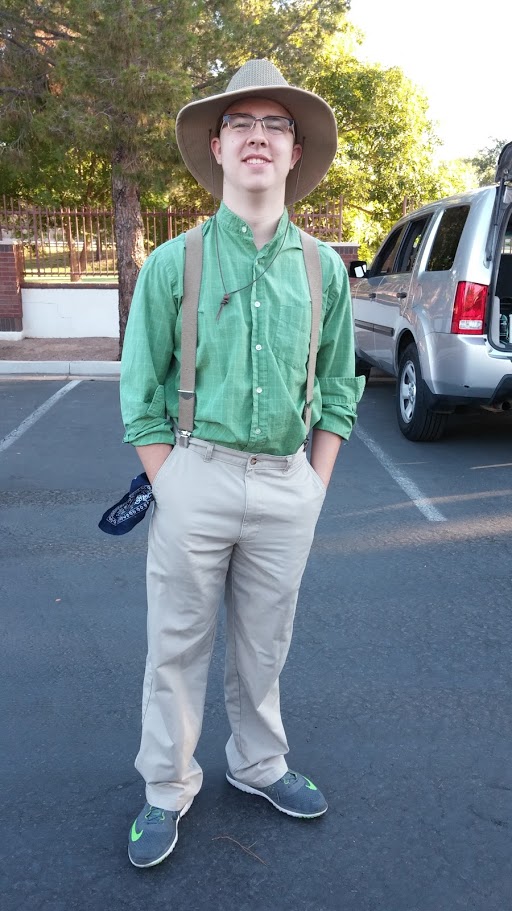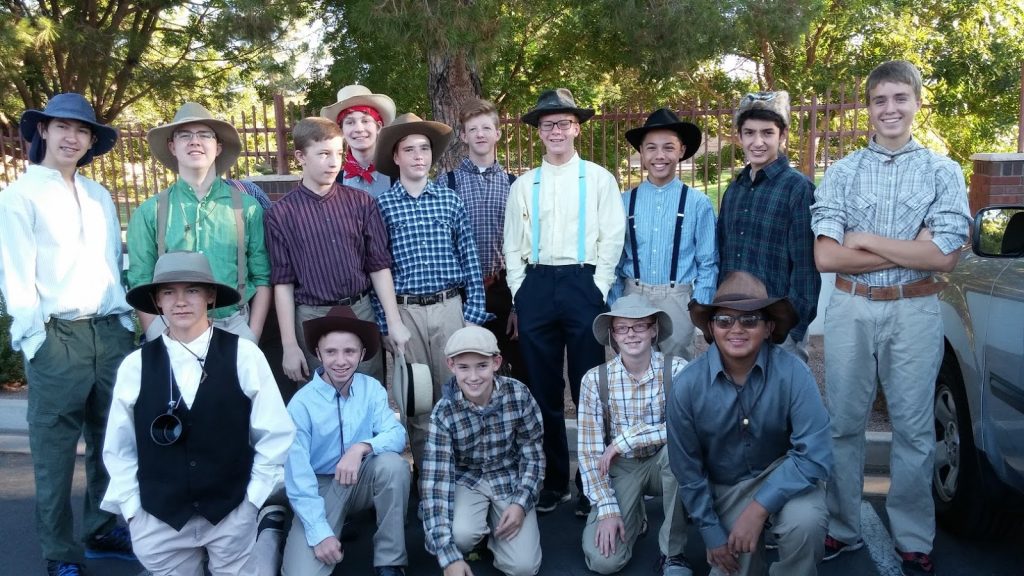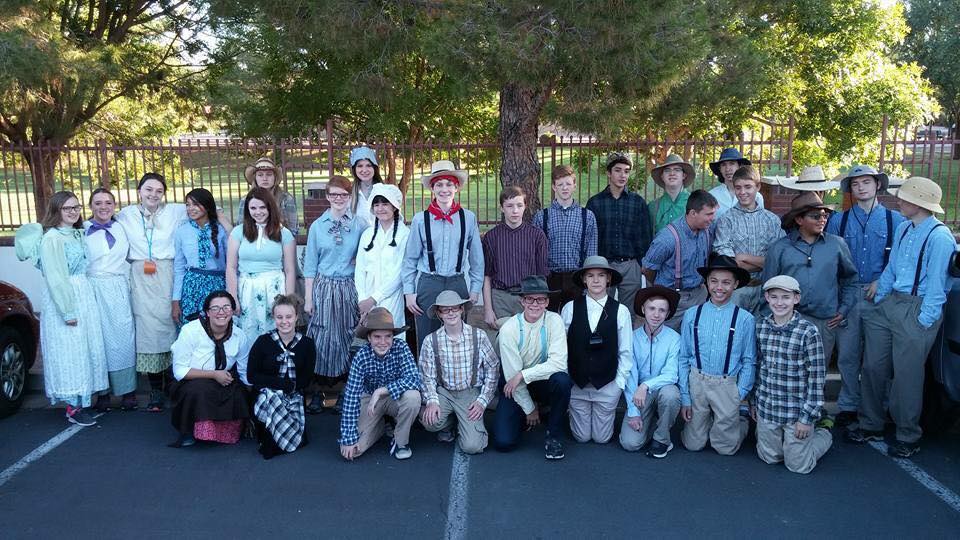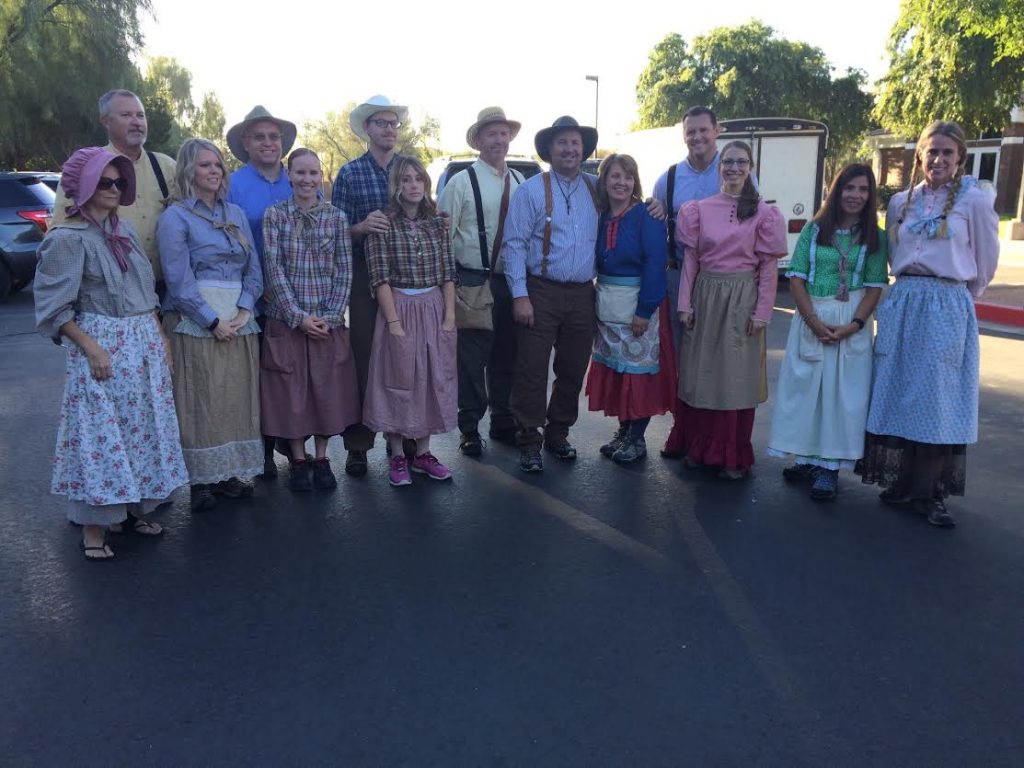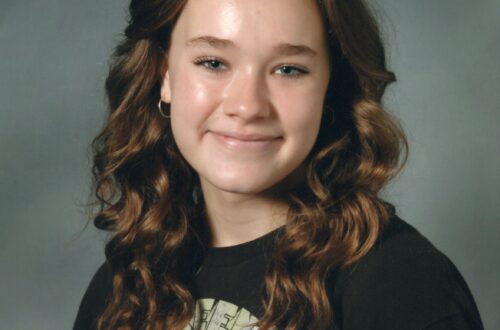Trek 2016
Every 4 years our Stake holds a Pioneer Trek for the youth ages 14-18. For four days they will be living as the Pioneers did. Walking on foot for 20 miles pushing and pulling handcarts. They will get to experience the faith and determination that was required of those early Saints. This will be an amazing testimony building adventure! I’m so excited Walker gets to go! I’m also a little jealous! LOL!!
All of their belongings had to fit in a 5 gallon bucket. The sleeping bag could be separate. You can see his gear behind him. Everything they take is put on a handcart wagon that the Youth are expected to pull/push all day every day!!! They are also set up in “families”. They have a Ma and Pa and Big Brothers and Big Sisters. All of whom are adults. This is to further give them the feeling of traveling like the Pioneers did.
There was a lot of preparation that went into getting ready for this event. They had personal goals they had to reach, scripture reading and memorization, physical preparation, and they needed to research a family member that was a pioneer.
The person they research is the name they will take with them on Trek. By that I mean they will think of their family member and how life was for them as they crossed the plains. How their testimony helped carry them through adversity of all kinds as they followed the counsel of the Prophet to travel to Salt Lake City. It’s to help them get a better understanding of their ancestor and to help them feel close to them and what sacrifices were made for them.
Walker chose his four times Great-Grandfather (on his maternal line) William Nicholas Goodman. Isn’t he handsome? 🙂
William was born in Bristol, England on September 9, 1841. He was left an orphan as a child. He was baptized into the Church of Jesus Christ of Latter Day Saints on May 13, 1851. In 1862 he left England for America with his brother. He was employed at foundry and carpentry work. Here is an excerpt from some family history records about his travels:
Brothers William and Nathaniel Goodman came to America
aboard the ship William Tapscott which left Liverpool 14 May 1862 and landed in
New York 26 June 1862. Reports indicate that the journey was rough and many of
the passengers were seasick. A shipmate, Ebenezer Farnes, wrote, “About
the third week on the voyage there came a terrible storm which tore everything
down that could be broken. So bad was the storm that the people had to stay in
their beds for three days, the hatchway being closed most of the time, the
water being one foot on the first and second decks, washing from one end of the
ship to the other and side to side, as the ship tossed and rolled. The captain
said it was the worst storm he had ever seen and he had been a captain for twenty-five
years. The ship sprung a leak and the pumps had to be kept going night and day
until we reached New York. When the captain was asked about the storm he said
if he had known the condition of the ship he would not have sailed on her but
consoled himself as he had a load of Mormons on board he would get through all
right as there had never been a ship lost that was carrying Mormons. After the
ship landed in New York, she was not considered fit to carry anything back but
lumber so they loaded her with that and she water-logged and was lost at sea.
Taking the voyage all in all, it was quite an experience for us all….Only two
deaths, one child and a man who was sick when he came on board. The burial at
sea is a sad thing. The body is sewn in a canvas and a ball of iron placed at
their feet so as to make the body sink feet first so the sharks cannot get it.
A long plank is placed on the rail of the ship, part on the ship and part over
the water, and the body is placed on the plank, feet to the water. After the
burial ceremony the plank is lifted at one end and the body slides into the
sea. You can see the body go slanting down for a long distance….Besides
having storms, we had calms which lasted from two to five days at a time.
Sometimes we had drifted forty or fifty miles out of course in all one trip. We
did not have favorable winds. All the winds were head winds so we had to tack.
During the calm the emigrants had a good time playing on deck, climbing up the
riggings, dancing, and playing games.”
aboard the ship William Tapscott which left Liverpool 14 May 1862 and landed in
New York 26 June 1862. Reports indicate that the journey was rough and many of
the passengers were seasick. A shipmate, Ebenezer Farnes, wrote, “About
the third week on the voyage there came a terrible storm which tore everything
down that could be broken. So bad was the storm that the people had to stay in
their beds for three days, the hatchway being closed most of the time, the
water being one foot on the first and second decks, washing from one end of the
ship to the other and side to side, as the ship tossed and rolled. The captain
said it was the worst storm he had ever seen and he had been a captain for twenty-five
years. The ship sprung a leak and the pumps had to be kept going night and day
until we reached New York. When the captain was asked about the storm he said
if he had known the condition of the ship he would not have sailed on her but
consoled himself as he had a load of Mormons on board he would get through all
right as there had never been a ship lost that was carrying Mormons. After the
ship landed in New York, she was not considered fit to carry anything back but
lumber so they loaded her with that and she water-logged and was lost at sea.
Taking the voyage all in all, it was quite an experience for us all….Only two
deaths, one child and a man who was sick when he came on board. The burial at
sea is a sad thing. The body is sewn in a canvas and a ball of iron placed at
their feet so as to make the body sink feet first so the sharks cannot get it.
A long plank is placed on the rail of the ship, part on the ship and part over
the water, and the body is placed on the plank, feet to the water. After the
burial ceremony the plank is lifted at one end and the body slides into the
sea. You can see the body go slanting down for a long distance….Besides
having storms, we had calms which lasted from two to five days at a time.
Sometimes we had drifted forty or fifty miles out of course in all one trip. We
did not have favorable winds. All the winds were head winds so we had to tack.
During the calm the emigrants had a good time playing on deck, climbing up the
riggings, dancing, and playing games.”
From
New York the Saints boarded a train for St. Joseph, Missouri, as far as the
railroad went at that time. Fellow traveler William H. Freshwater wrote in his
journal, “Just before we arrived in St. Joseph, Missouri, the rebels, or
bushwhackers, [This was during the Civil War.] fired two cannon balls through
our train, one shot went through the passenger car exactly eight inches above
the peoples’ heads and the other through a baggage car destroying a great
amount of baggage.We stayed in St. Joseph three or four days, afraid to go on
because of the rebel soldiers being all throughout the country. While we were
there, some fifteen rebel soldiers were taken prisoner, right from among our
company, by the northern soldiers. Two companies of Union soldiers surrounded
the depot and made the rebels surrender or they would have killed them.
New York the Saints boarded a train for St. Joseph, Missouri, as far as the
railroad went at that time. Fellow traveler William H. Freshwater wrote in his
journal, “Just before we arrived in St. Joseph, Missouri, the rebels, or
bushwhackers, [This was during the Civil War.] fired two cannon balls through
our train, one shot went through the passenger car exactly eight inches above
the peoples’ heads and the other through a baggage car destroying a great
amount of baggage.We stayed in St. Joseph three or four days, afraid to go on
because of the rebel soldiers being all throughout the country. While we were
there, some fifteen rebel soldiers were taken prisoner, right from among our
company, by the northern soldiers. Two companies of Union soldiers surrounded
the depot and made the rebels surrender or they would have killed them.
We went
from St. Joseph to Florence (Nebraska) by steamboat up the Missouri River. We
stayed at Florence (which was three miles above Omaha). Omaha had six houses
and Florence, seven, all of which were trading posts.” After about two
weeks in Florence, the company began the trek across the plains. William traveled with the Horton D. Haight Company. They arrived
in the Salt Lake valley in early October.
from St. Joseph to Florence (Nebraska) by steamboat up the Missouri River. We
stayed at Florence (which was three miles above Omaha). Omaha had six houses
and Florence, seven, all of which were trading posts.” After about two
weeks in Florence, the company began the trek across the plains. William traveled with the Horton D. Haight Company. They arrived
in the Salt Lake valley in early October.
William served a mission in Great Britain for a short time and was a body guard to Brigham Young. He did considerable work for the Prophet. He had various church callings and served with honor. In 1877 he was called to work on the St. George Temple in Utah. He also served in the Black Hawk War in 1866. In 1882 he moved his family to Mesa, AZ and a short time later moved down to the San Pedro Valley and stopped in St. David to spend time with his wife’s sister’s family. He died on March 8th, 1885 (he was only 44 years old) and is buried in the St. David Cemetery in AZ. He left behind his wife and 9 children.
Walker and all the youth in our Ward met at the church bright and early at 6:30am this morning.
The Young Men.
The Young Men and Young Women.
The Ma’s, Pa’s, Big Brothers and Big Sisters. (Sorry for the poor quality. I’m trying to get a better copy. 😛 )
I can’t wait to hear all about his experience at the end of the week!! I know this is going to be an amazing spiritual and testimony building week!
